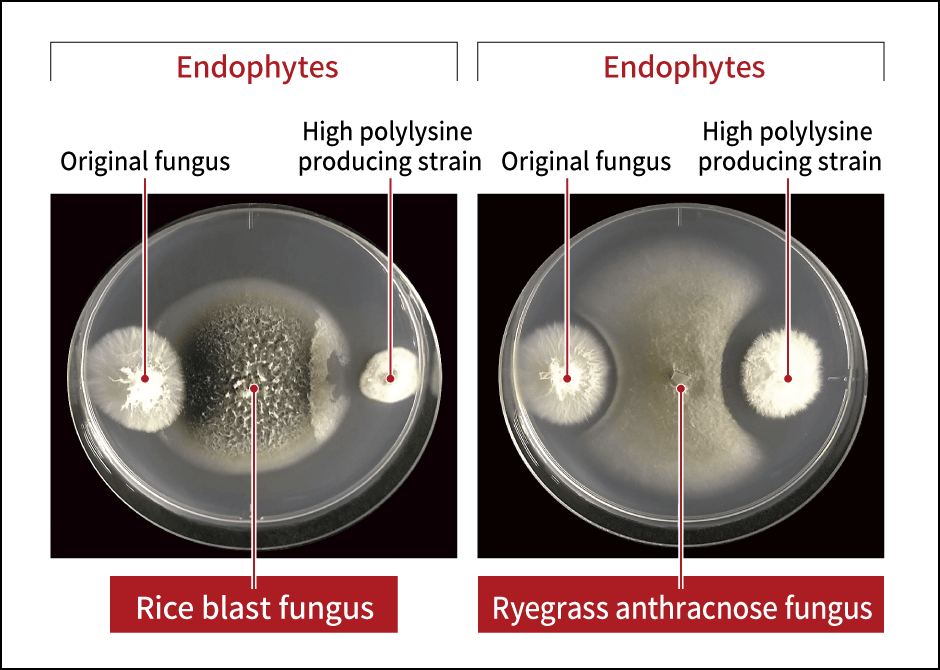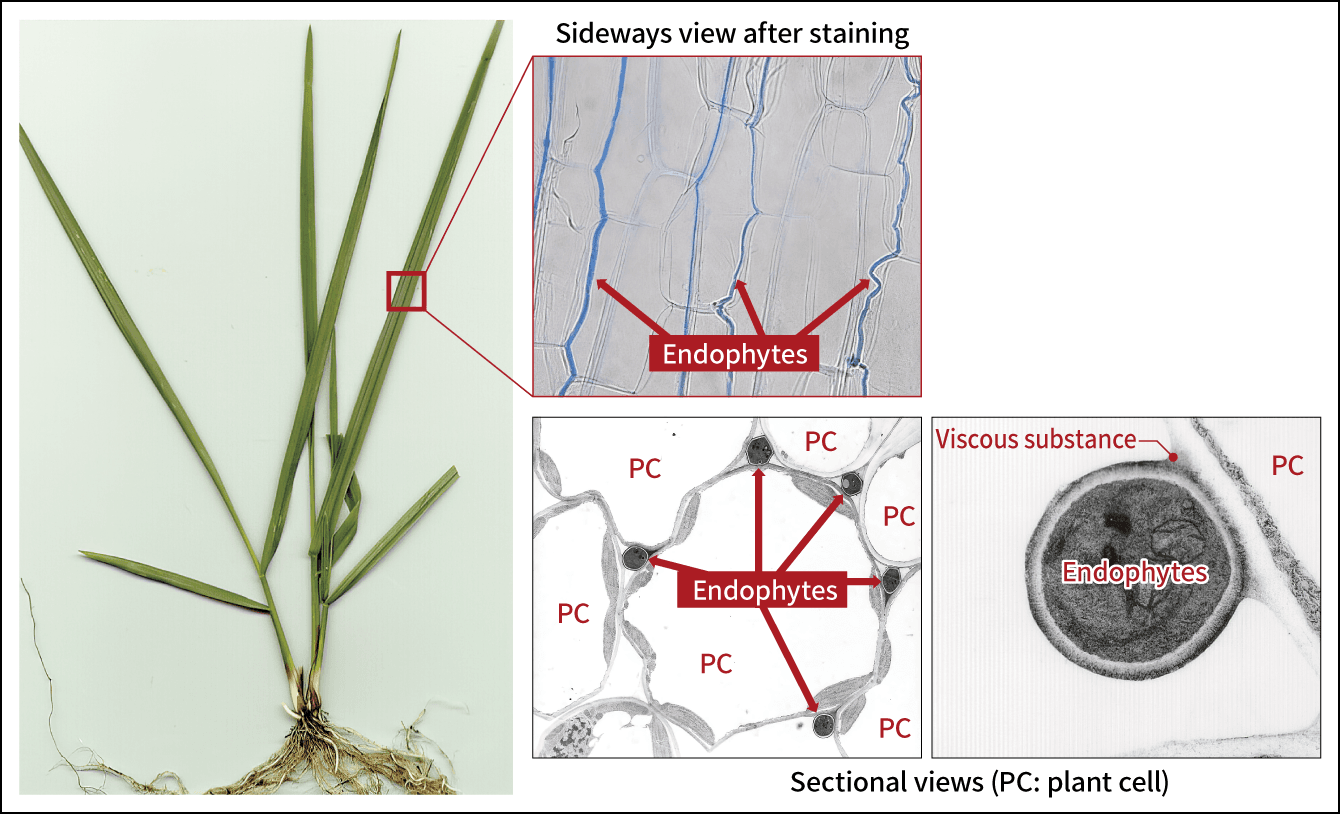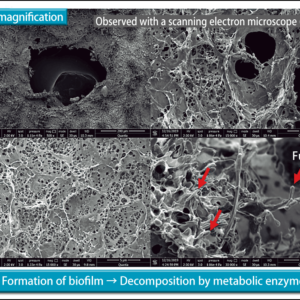Over the course of their evolution, the ancestors of plants incorporated microbes called cyanobacteria and gained the ability to carry out photosynthesis to produce organic matter from inorganic substances. As a result, plants came to play a part in nourishing almost all living organisms. Furthermore, plants developed more sophisticated immune functions thanks to symbiosis with microorganisms called endophytes, evolving in tandem with them, leading to the acquisition of temperature resistance and other functions that minimized the adverse impacts of the external environments. The interests of plants and endophytes are similar, and one might say it was the providence of nature that resulted in their finding common ground after a long time.
Special Feature 1 – The Wondrous Survival Strategies of Plants How plants gained the ability to defend themselves against “enemies” via symbiosis with microbes
composition by Rie Iizuka
illustration by Koji Kominato
There are countless examples of plants and endophytes building symbiotic relationships beneficial to the coexistence of both.
First, let us define what an endophyte is.
Used as the generic term for microorganisms that live inside plants, the word “endophyte” is formed of two elements derived from Greek: “endo–,” meaning “inside,” and “–phyte,” meaning “plant.” It seems that, in days gone by, mold was thought to be a type of plant, so the name was devised to refer to them as “plants within.”
Just as intestinal bacteria live inside our bodies, various microorganisms coexist inside plants. Endophytes are microorganisms found in plant tissue and can broadly be divided into bacterial endophytes, which are prokaryotes, and fungal endophytes, which are eukaryotes.
Maintaining a delicate balance to sustain a symbiotic relationship
Endophytes include not only symbiotic microbes that benefit the plant, but also those that merely live off the plant, receiving nutrients from it without doing anything in particular in return. While the latter type seems to make up the majority, future advances in research might well reveal advantages to the plant in symbiosis with some of them.
Microorganisms that are clearly harmful to a plant are deemed to be pathogens and are not called endophytes. The tricky thing is that some endophytes that initially coexisted with a plant go on to behave like pathogens as the plant moves into a different stage in its growth. Plants and endophytes maintain a delicate balance to sustain their symbiotic relationship.
Let us look at the history of the symbiotic relationships that plants have built with microorganisms.
The relationship between the two is ancient, stretching back 1.5 billion years. Over the course of their evolution, plants incorporated cyanobacteria —— bacteria capable of photosynthesis —— and, in doing so, gained this ability for themselves. In a manner of speaking, plants are a phylogenetic group that came into being as a result of symbiosis with bacteria. Eukaryotes are themselves a phylogenetic group that appeared after being infected by aerobic bacteria, which are capable of breathing, and plants are a phylogenetic group that incorporated microbes capable of photosynthesis. It would therefore be fair to say that plants have cooperated with endophytes from the time of their birth.
Some time after the ancestors of plants first appeared, plants formed new symbiotic relationships with mycorrhizal fungi. When their roots were infected with mycorrhizal fungi, the roots of the fungus stretched out beyond the tips of the plant’s own roots, enabling the plant to absorb a larger quantity of nutrients from the soil (Figure 1). It is said that plants needed to absorb nutrients with the aid of mycorrhizal fungi in order to expand onto land. The oldest fossil in which such infection has been found is 400 million years old, so we know that at least some species of mycorrhizal fungi have infected plant roots and maintained a symbiotic relationship with them since that time.

Figure 1. Mycorrhizal fungi aid plants in absorbing nutrientsA situation where a root has an infecting fungus attached to it is called a mycorrhiza and the fungi that give rise to them are generally called mycorrhizal fungi.
Symbiosis with plants also benefits the microorganism
More than 80% of the plants on Earth today have roots infected with mycorrhizal fungi. The fossil dating back 400 million years shows traces of infection by the fungal forebears of mycorrhizal fungi not only on the roots, but also on the stem. Primitive plants are thought to have had roots growing above the ground, which were too weak to absorb nutrients well, and therefore made use of fungi to supplement what they lacked.
The phylogenetic group of mycorrhizal fungi infecting plants is called Glomeromycota; they are generally referred to as arbuscular mycorrhizal fungi and first appeared between 400 and 500 million years ago. They make up a small phylogenetic group within the kingdom of fungi and appear to have emerged at the same time as plants moved onto the land. In fact, this phylogenetic group of fungi with the ability to coexist with the plants moving onto the land is believed to be thriving independently alongside plants today almost entirely unchanged.
Over the course of plants’ evolution, powerful pathogens must have emerged that caused the extinction of some plant species. From the perspective of the fungi, losing the plants that they infected would have forced them back into the soil, where they faced a fierce struggle for survival against other fungi. Symbiosis with plants is thought to have benefited the microorganism as well, and, over time, molds and mushrooms emerged that began to coexist with plants.
Symbiosis with useful microorganisms in the form of endophytes gave plants greater resistance to dryness and salt, giving rise to advantages such as a better ability to withstand osmotic stress, greater resistance to heavy metals and environmental resilience. Symbiotic relationships take a wide range of forms, but in quite a few cases, although the phenomenon is known to occur, the precise mechanism remains unclear.
Plants have acquired a tremendous power in their ability to carry out photosynthesis, which enables them to produce organic matter. As this abundant organic matter is also highly attractive to other organisms as a source of nutrition, various organisms began to target plants. Accordingly, endophytes coexisting with plants cooperated to arm themselves against these “enemies.”
Broadly speaking, plants use their symbiotic relationships with endophytes to ward off external “attacks” in three ways: (1) inhibiting predation; (2) inhibiting pest damage; and (3) inhibiting disease.
Research into these symbiotic relationships has advanced by studying plants such as perennial ryegrass (Lolium perenne), which belongs to the Poaceae (grass family).
It was in the 1980s that this phenomenon first came under the spotlight. In New Zealand, sheep grazed on pasture were found to be staggering, while in the U.S., cattle were affected by a disorder in which poor blood flow to their extremities caused necrosis. Upon further investigation, scientists found that the perennial ryegrass eaten by the affected animals was infected with an endophyte belonging to the genus Epichloē, which produces the toxic substances ergovaline and lolitrem B.
Next, some were found to produce peramine, which insects dislike and which demonstrates a repellent action. The endophyte synthesizes peramine comparatively easily from the basic amino acids proline and arginine found in the plant. If the plant was infected with an endophyte without the ability to synthesize peramine, it would be devoured by insects. Figure 2 shows a comparison of a field planted with perennial ryegrass infected with Epichloē and uninfected perennial ryegrass. You can see a clear boundary between the two sides, as insects do not try to eat the infected perennial ryegrass. For the perennial ryegrass, incorporating endophytes reduces the risk of predation by animals and insects.

Figure 2. Endophyte infection and predationThere is a clear difference in the extent of insect predation between the grass with the symbiotic endophyte and the uninfected grass.
The third defense mechanism is the synthesis of an antimicrobial substance. There are many different kinds of grass diseases, including dollar spot and crown rust. Endophyte infection is known to markedly improve resistance to such diseases. However, the degree of resistance varies according to the combination of endophyte strain and pathogen.
Upon investigating the substances synthesized and the genes involved in this process, our team found the gene that produces an antimicrobial substance called polylysine. We also succeeded in substantially inhibiting pathogen activity by modifying this gene and introducing it into endophytes (Figure 3).

Figure 3. Effects of polylysine on pathogensThe endophytes produce an antimicrobial substance called polylysine. When cultured along with the endophytes, it strongly inhibits pathogen growth.
Thus, it would appear that plants’ immune functions cannot act against endophytes with which they have a symbiotic relationship, and that they have acquired a means of coexisting with them as “friends,” but it also appears from the behavior of the endophytes that they intend to coexist with the plants concerned.
Fungi generally have two ways of alternating generations: sexual and asexual reproduction. Sexual reproduction involves interbreeding, while asexual reproduction involves ongoing production of copies of the parent, without any mingling of the parent’s genes with others. As endophyte infections are found throughout the plant world, plant seeds are also completely infected in the case of asexual reproduction. If a new plant grows from a fallen seed, the life cycle is such that the endophyte will also coexist with it. Protecting the symbiont it has formed with the plant is an effective means of preserving the endophyte’s lineage.
If we map the evolution of a plant and its symbiotic endophyte, we will end up with similar phylogenetic trees (Figure 4). This shows that the two have built up a relationship over the lengthy history of their evolution.

Figure 4. Comparison of the phylogenetic trees of a plant and its symbiotic endophyteThe host plant and the symbiotic endophyte have differentiated together over their lengthy history.
The endophytes tolerated by plants are extremely limited, so these relationships have more or less a one-to-one correspondence. In other words, there is a clear distinction between endophytes that are not affected by the immune process and those that are eliminated by it, but endophytes demonstrate a particular behavior when evading immune networks.
Controlling gene activation after perceiving an infection
For example, as soon as an endophyte infects a plant, it begins to produce substances that are toxic to predators of the plant or that repel insects. The plant accepts the endophyte infection because these compounds are beneficial to the plant.
Moreover, the endophyte only synthesizes these substances beneficial to the plant when it has infected a plant and stops synthesizing them if it leaves the plant. Clearly, it would be fair to say that endophytes control the activation of their genes in response to the infection.
To maintain this symbiotic relationship, endophytes also have a mechanism enabling them to match the pace at which they spread to infect the plant to the pace of the plant’s growth.
When a pathogen infects a plant, the infection progresses extensively and the pathogen ultimately absorbs the plant’s nutrients, causing the plant to wither.
However, an endophyte sends a single hypha to infect the gap between two cells and does not enter the cells themselves (Figure 5). The hyphae can be seen to grow out sideways, as though creating a network. As plants are affected by environmental factors such as sunlight and nutrients, they do not grow at a set pace, but the fungus will tailor the growth of the intermediate parts of the hyphae to the pace of the plant’s growth. Generally speaking, it is the tips of fungal hyphae that grow in spurts, so the network created by endophyte hyphae is a mechanism for gaining information about the plant’s growth and evading its immunity. This could be described as a special ability gained by endophytes to facilitate symbiosis with plants and is key to maintaining the relationship between the plant and the endophyte. Variants incapable of creating a hyphal network within a plant cause the plant to wither and are therefore unable to maintain a symbiotic relationship.

Figure 5. Example of a fungal infectionWhen it infects a plant, an endophyte weaves its way between one plant cell (PC) and another. It should also be noted that the hypha is viscous and sticks to the gaps without entering the cells. The blue lines in the micrograph (sideways view) are the stained hyphae. A pathogen will spread throughout the plant’s tissue, causing it to wither, whereas an endophyte puts out hyphae that grow at a more moderate pace. It is a mild infection, with a single hypha entering a single gap, as though maintaining a balance with the plant.
Some endophyte species with a long history of plant symbiosis have lost their sexual reproduction functions or the genes that synthesize the proteins required to survive on their own. The plant provides what they need.
Symbiotic relationships between plants and endophytes have become closer through the ages; in evolution, one customarily finds that if the struggle between a plant and a fungus continues for long enough, they will eventually find common ground. The providence of nature thus teaches us that it is better to coexist peacefully than to battle against each other.




















